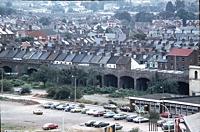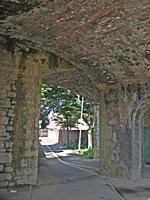
The Atmospheric Railway
Page updated 26th February 2014
Back to historic events in Exeter
When the Bristol and Taunton railway reached Exeter St David's, in May 1844, plans were were already in hand to continue the line down to Plymouth and beyond. The Plymouth, Devonport & Exeter Railway Company had been formed as early as 1840 to promote such a line. In 1843, when I K Brunel was appointed as its engineer, the name was changed to the South Devon Railway. On the 4th July 1844, an Act of Parliament was obtained for its construction and work commenced. This history is only concerned with the atmospheric railway line as far as Newton Abbot.
The Route
The first consideration for Brunel was the route to
be taken; despite warnings from others, he decided that the line would
follow the west bank of the Exe estuary, hug the coast between Dawlish
and Teignmouth, in parts tunnelling through headlands, while in other
places it would run on a narrow strip between the English Channel and
steep, red sandstone cliffs. From Teignmouth, the line would pass along
the northern bank of the Teign estuary until it reached Newton Abbot.
The line was to be single track, broad gauge and, most controversially,
worked by the still experimental system of atmospheric propulsion.
Brunel proposed the single track, broad gauge line to save on
engineering costs. Leaving St David's, the line immediately crossed the
River Exe on a wooden bridge to St Thomas which it crossed on a 548
yard viaduct, built by Samuda & Clegg, to clear the three main
roads converging on the Exe Bridge. In St Thomas, a station by Cowick
Street was built which would become the head quarters of the South
Devon Railway Co. The station that we see today was built in 1861 when
the track was twinned and the viaduct widened, as is evident by the two
styles of stone work under the arches.
The line as far as Newton Abbot would be level, although, as since
demonstrated, at the mercy of storm waves from the English Channel.
Brunel was concerned that the current technology of the steam engine
would prove to be inadequate for the steep gradients that the line
would encounter beyond Newton Abbot as it approached Totnes, and later,
as it skirted Dartmoor.
The Atmospheric System
The choice of the atmospheric propulsion system was
made after Brunel had seen the atmospheric Samuda and Clegg built
Kingston & Dalkley Railway near Dublin in operation. Along with a
test line at Croydon, the system had impressed Brunel for him to
recommend it to the shareholders of the South Devon Railway.
He believed that the system would be economical to build, save
fuel,
allow trains to ascend the steep gradients beyond Newton Abbot, give a
silent, smooth and fast ride for the passengers, and would be clean,
avoiding the smuts that plagued conventional railway systems.
The proposed system used a 15 inch pipe with a slit along the top
that
was covered with a flap valve to maintain an internal vacuum,
positioned between the rails. The valve had an ox-hide leather seal
which was greased, initially with lime soap and later with cod oil and
soap. Pumping stations were constructed every three miles at Exeter St
David's (became a water tower), Countess Wear, Turf, Starcross (still
exists), Dawlish, Teignmouth, Bishopsteignton and Newton Abbot. Each
pumping station would evacuate the pipe of air, according to the
timetable, which proved to be very wasteful if the train was no ready
to leave the previous stop. Although the telegraph had been run along
the line, it was not installed in the pumping stations - if it had,
precious coal would have been saved.
Beneath the leading piston carriage hung a 15 ft long piston shaped
like a dumbbell, with small wheels outside the pipe, and before and
after the piston, that opened and pressed close the iron and leather
flap valve. The piston entered the end of the pipe from which the air
had been evacuated, the brakes released, and pressure from the
atmosphere would push the piston up the pipe, behind the vacuum created
by the pumping engine. A small, supplementary vacuum pipe and piston to
the side of the rail and between each section was used to haul the
train with a rope to the next main section of vacuum pipe at stations.
The first trains
The route as far as Teignmouth opened on 30th May 1846 with conventional engines and on the 22 December 1846 the first train, comprising of a large number of trucks, hauled by two engines, in total weighing 300 to 400 tons, reached Newton Abbot. On the 31 December, after the line had been passed as safe by the Government inspector, the Sun Class locomotive, Antelope left Exeter at 9.55 am and arrived at Newton at 10.45 am with its first passengers.
During 1846, the installation of the atmospheric system took place alongside the regular timetable to Teignmouth. On 25 February 1847 the first carriage with a piston attached was delivered at Exeter and a short test to Turf made on the same evening. Problems were apparent from the start, as the carriage, towing a locomotive proceeded very slowly due to water and dirt in the pipe.
The next day Brunel with Samuda made his first trip, although the middle section at Countess Wear needed a tow, as the pumping house was not working. Over the next few months, many problems became apparent to the engineers. The steam engines at the pumping houses were underpowered, and unreliable, due to poor workmanship, and the valve on the pipe was causing problems. It was not until the 16 August 1847 that the first atmospheric hauled train reached Teignmouth.
Two atmospheric trains per day left Exeter, for a return trip to Teignmouth on an experimental basis. Speeds as high as 45 mph were reached in the 40 minute journey, albeit, without a single passenger. Trials with trains hauling 120 tons were made and on one occasion, the 8½ mile journey from Exeter to Starcross took just 15 minutes. On the 13 September, the public were allowed to ride on the train for the first time, when two trains per day were run.
Gradually, over the next few months, the conventional locomotives were withdrawn from service, and the atmospheric system took over. By 17 December, atmospheric trains were reaching as far as Newton Abbot. On the 23 February 1848, the changeover was complete, and the worlds longest atmospheric railway was in full operation.
More problems
The valve in the pipe continued to give problems, and to keep the railway running a gang of men was employed full time to keep the valve well greased and free from leakage.
In addition, the pumping engines, designed for 13 inch pipes, were taking longer than expected to exhaust all the air from the pipe ready for a train. This along with the lack of a telegraph increased coal consumption, and costs.
The service was remarkably reliable, despite the difficulties, until December 1847 and January 1848, when the severe cold froze the valve shut on several occasions, or it leaked due to cracking; on these days, a conventional locomotive was used to maintain the service.
Losses mount
By June 1848, the increased cost of coal, and maintenance, incurred a loss for the previous six months, of £2,487. The actual running cost was more than 7 pence per mile higher than a locomotive hauled railway. Brunel discovered that each pumping engine required almost three times the power that he first calculated to exhaust the pipe, primarily due to leakage.
Plans were made to improve the system to prevent failure in the future and reduce running costs. A rubber valve was ordered, and the feasibility of galvanising the valve was investigated, to prevent corrosion. The cost was estimated at £1,160 per mile of some £25,000 in total.
However, by August, the directors of the railway were becoming impatient with Brunel, and indeed, Brunel was becoming disillusioned with the project. Brunel had submitted a verbal report to the directors on 1 August when he outlined the difficulties so far encountered with the system. He considered that virtually the whole of the valve would need replacing, a job that would take a year, and that the underpowered pumping engines would need a good deal of work to upgrade them. As a consequence, he did not recommend that the atmospheric working be extended beyond Newton Abbot, and recommended that the expense of putting the system right could not be justified, unless Samuda would guarantee the works.
Closure
On 29 August, the Board of the South Devon Railway Company decided that atmospheric working would cease on the 9 September. From that date steam locomotives replaced the pumping houses, and the atmospheric equipment sold off. One pumping engine found its way to a lead mine near Ashburton, and some of the pipe was used to drain the marshes of Goodrington for the Dartmouth and Torbay Railway Company. The only reminder of Brunel's Atmospheric Caper is the engine house at Starcross. Nothing can be found of the pumping houses at Turf and Countess Wear, although the Exeter St David's pumping house had a water tower added to it before it was removed quite recently.
Brunel was heavily criticized by the board of the South Devon Railway, some of whom had questioned the fees that Brunel had negotiated. Brunel countered this charge by stating that he had reduced the fee for his workmen on the system, had not taken his own £6,000 fee, and had lost £20,000 of his own money which had been invested in the venture.
It is apparent now, that Brunel made two fatal mistakes. The first was that he failed to understand, that steam engine technology was evolving very fast, and that by the time his railway was running to Plymouth, the latest steam engines would have more than enough power to climb the gradients, west of Newton Abbot. His second mistake is that he placed too much faith in Samuda and Clegg's technology, which had proved effective for a short time, on the much smaller system at Croydon – however, material technology of the time was not advanced enough, leading to the ineffective leather valve system, which could not withstand the elements. Even with our modern materials, it is unlikely that an atmospheric railway, similar to Brunel's would be successful today. Brunel was a brave engineer who backed an unproven system – in his favour, he was also brave enough to go to the directors and tell them that the system wasn't working, losing a large amount of his own money in the process.
Sources - The South Devon Railway by R H Gregory, Exeter to Newton Abbot by Mitchell and Smith, and the Life of Isambard Kingdom Brunel (1870) by I Brunel (son of IKB)
│ Top of Page │





